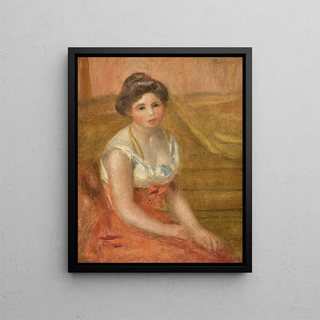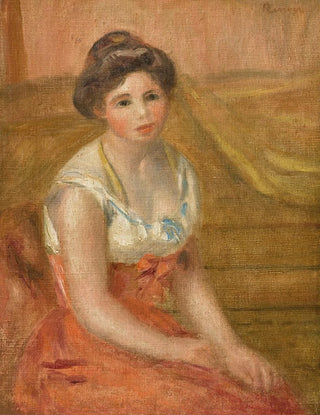Art print | Seated woman - Pierre-Auguste Renoir


View from behind

Frame (optional)
Pierre-Auguste Renoir’s art print "Seated Woman" is an iconic masterpiece that transcends time and artistic trends. Created at the heart of the Impressionist movement, this piece embodies the lightness and sensuality characteristic of Renoir’s work. The depiction of a woman, both intimate and universal, invites deep and delicate contemplation. Vibrant colors and fluid brushstrokes evoke an atmosphere of serenity, where every detail seems to breathe life. Through this art print, Renoir manages to capture not only the physical beauty of his model but also a palpable emotion, making this art print unforgettable and timeless.
Style and uniqueness of the art print
Renoir’s style in "Seated Woman" is distinguished by a bold approach to light and color. The artist uses warm, luminous tones to create a soft and welcoming ambiance. The woman, seated in a relaxed pose, is enveloped in natural light that accentuates the curves of her body and the texture of her clothing. The brushstrokes, both swift and delicate, testify to a technical mastery that gives the art print a sense of movement and vitality. True to his Impressionist style, Renoir does not aim to reproduce reality precisely but rather to evoke a sensation, an atmosphere. Every element of the composition, from the blurred background to the elegant posture of the woman, contributes to creating a visual harmony that charms and captivates the viewer.
The artist and his influence
Pierre-Auguste Renoir, a central figure of Impressionism, left a lasting mark on art history with his unique vision and innovative approach. Born in 1841, he began his career painting scenes of everyday life, landscapes, and portraits, always with a keen attention to light and color. His influence extends far beyond his era, inspiring many artists who followed in his footsteps. Renoir distanced himself from the academic conventions of his time to embrace a freer, more expressive aesthetic. His work on the representation of femininity, notably through works like "Seated Woman," paved the way for

Matte finish

View from behind

Frame (optional)
Pierre-Auguste Renoir’s art print "Seated Woman" is an iconic masterpiece that transcends time and artistic trends. Created at the heart of the Impressionist movement, this piece embodies the lightness and sensuality characteristic of Renoir’s work. The depiction of a woman, both intimate and universal, invites deep and delicate contemplation. Vibrant colors and fluid brushstrokes evoke an atmosphere of serenity, where every detail seems to breathe life. Through this art print, Renoir manages to capture not only the physical beauty of his model but also a palpable emotion, making this art print unforgettable and timeless.
Style and uniqueness of the art print
Renoir’s style in "Seated Woman" is distinguished by a bold approach to light and color. The artist uses warm, luminous tones to create a soft and welcoming ambiance. The woman, seated in a relaxed pose, is enveloped in natural light that accentuates the curves of her body and the texture of her clothing. The brushstrokes, both swift and delicate, testify to a technical mastery that gives the art print a sense of movement and vitality. True to his Impressionist style, Renoir does not aim to reproduce reality precisely but rather to evoke a sensation, an atmosphere. Every element of the composition, from the blurred background to the elegant posture of the woman, contributes to creating a visual harmony that charms and captivates the viewer.
The artist and his influence
Pierre-Auguste Renoir, a central figure of Impressionism, left a lasting mark on art history with his unique vision and innovative approach. Born in 1841, he began his career painting scenes of everyday life, landscapes, and portraits, always with a keen attention to light and color. His influence extends far beyond his era, inspiring many artists who followed in his footsteps. Renoir distanced himself from the academic conventions of his time to embrace a freer, more expressive aesthetic. His work on the representation of femininity, notably through works like "Seated Woman," paved the way for






